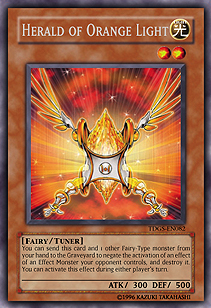 and Shonen Jump Championship Seattle have set the trends that will shape the next few months of dueling: Teleport Dark Armed Dragon is on top, and the only other deck to have significant representation in Day 2 thus far is Lightsworn. That’s not to say that those two decks are the only ones worth playing, but they are two decks you should be ready to beat if you’re heading into a major competition. Figuring out how to beat those decks is the kind of challenge a lot of players love, myself included.
and Shonen Jump Championship Seattle have set the trends that will shape the next few months of dueling: Teleport Dark Armed Dragon is on top, and the only other deck to have significant representation in Day 2 thus far is Lightsworn. That’s not to say that those two decks are the only ones worth playing, but they are two decks you should be ready to beat if you’re heading into a major competition. Figuring out how to beat those decks is the kind of challenge a lot of players love, myself included.
With that said though, I think the most interesting deck in the format right now is actually Lightsworn. Teleport Dark Armed Dragon didn’t change much between Tulsa and Seattle, and winning versions are unlikely to change many cards over the coming weeks. Lightsworn is still a total mystery by comparison. The builds that have made Day 2 in recent tournaments have shared a few things in common. They’re progressively getting smaller, hugging 40 cards. Most builds are either playing to take advantage of multiple copies of Beckoning Light or playing Royal Decree. But beyond those similarities there’s been tremendous variation. Herald of Orange Light, Quillbolt Hedgehog, multiple copies of Ehren, Lightsworn Monk, Necro Gardna, and plenty of other cards remain purely optional. There is no dominant build yet, and the fact that Lightsworn still hasn’t broken into the finals has left players at a loss as to what version they should play.
I think the answer is "none of the above." The reality is that the builds we’ve already seen have reached a plateau, and I don’t think they can go any further. If they do, it will likely be owed to an extreme stroke of luck. What Lightsworn need right now is what Eric Ing delivered for Gladiator Beasts: evolution.
The Big Problem is Synchros
Synchros provide a dual challenge to the Lightsworn player. On one hand, the existence of Synchros in the play environment is a huge handicap to Lightsworn on a deckbuilding level, because they can’t use them. Don’t get me wrong, I have tremendous respect for Bryon Mines and his ability to take 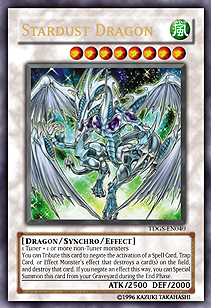 and Herald of Orange Light to Day 2 in Baltimore. And I do think Herald of Orange Light is a very useful monster. But Herald’s a dual-purpose card to begin with, and there’s nothing that lets you search it out (like Emergency Teleport). Synchros are an afterthought in Lightsworn because the deck doesn’t have the right Tuner yet.
and Herald of Orange Light to Day 2 in Baltimore. And I do think Herald of Orange Light is a very useful monster. But Herald’s a dual-purpose card to begin with, and there’s nothing that lets you search it out (like Emergency Teleport). Synchros are an afterthought in Lightsworn because the deck doesn’t have the right Tuner yet.
Normally a deck could overcome that type of handicap by simply doing what it does extremely well, but the fact that Synchros are doing so much for other decks is the real nail in the coffin. I’ve played 100 to 110 games of the TeleDAD/Lightsworn matchup lately. It’s not a huge number, but it’s enough to figure out the one play that crushes this deck: the Synchro summon of Stardust Dragon followed by Colossal Fighter.
Stardust Dragon is difficult for Lightsworn to deal with because it’s bigger than anything Lightsworn play short of Judgment Dragon, and it repels traditional Lightsworn removal cards with ease: Celestia, Lightsworn Angel, Ryko, Lightsworn Hunter, and even spells like Soul Taker are instantly stymied. The only way to get over Stardust Dragon is to have Honest in hand, or to attack over it with Judgment Dragon. The latter usually robs you of what would have otherwise been a kill turn since you can’t clear the field with that Dragon until main phase 2. And that’s if the Judgment Dragon even gets through Solemn Judgment, which darn near every TeleDAD deck should probably be playing.
Colossal Fighter is the second star in the Lightsworn matchup. When it attacks a Lightsworn monster and Honest is played in response, Colossal Fighter just special summons itself again. So while the Lightsworn player dealt some damage and kept one of his or her monsters alive, Colossal Fighter’s controller didn’t actually lose any cards. He or she can attack another monster, too. It forces the Lightsworn player to waste copies of Honest or simply take a hit when it attacks. And it’s equally brutal in defense position as well, blocking as many Lightsworn attacks as you can throw at it.
But as good as those monsters are on their own, the real problem occurs when they hit the field together. On their own, Stardust and Colossal can be dealt with: the Lightsworn player can force his or her opponent to tribute Stardust, and then mount a big attack. Alternatively 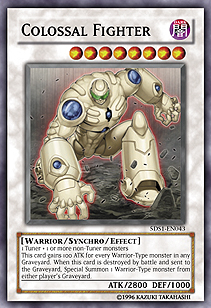 that player can save a copy of Honest to press over Stardust Dragon. Colossal Fighter is vulnerable to Celestia, Ryko, and Judgment Dragon.
that player can save a copy of Honest to press over Stardust Dragon. Colossal Fighter is vulnerable to Celestia, Ryko, and Judgment Dragon.
But together the situation is different. If you play Honest to get over Stardust Dragon, you still need to deal with Colossal Fighter and you now have one less way to rebuke its attack next turn. Alternatively, if you have the Celestia or Ryko to deal with Colossal Fighter, but Stardust is present on the field, you can’t touch either of them. Even if you have Judgment Dragon to attack over Stardust Dragon and then raze the field to get rid of Colossal Fighter, you’ve had to forego a potential win-turn as mentioned earlier. With just two Judgment Dragon cards per deck it doesn’t happen reliably anyway.
It’s this two-Synchro pincer attack that’s keeping Lightsworn down at the moment, and I really think future builds of the deck need to dedicate space to counter it. Step one is simple Synchro tech: John Umali made it to Day 2 this past weekend with a pair of Compulsory Evacuation Device cards, and I think it’s a great choice, but that alone can’t fix this problem. The reality is that the deck needs to be adapted on fundamental levels if it’s going to cross the final threshold.
And There Are Two Ways To Do It
First, no matter what solution you opt to go with, we need to recognize that there are cards currently being played that don’t do much in the TeleDAD matchup. Namely, Necro Gardna and Crush Card Virus. The Virus is extremely hard to pull off in your average Lightsworn build, and in my testing Necro Gardna only seemed to prolong an inevitable loss. What few games they won already favored the Lightsworn player. If you can send multiple copies of 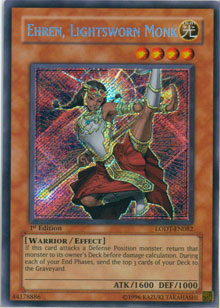 to the graveyard you’ll likely have to use them in a single turn, which isn’t particularly great. One turn just isn’t much time these days. Drawing them is far worse, and while the accepted logic is that you’ll only draw them rarely and can funnel them through Lumina, Lightsworn Summoner when you do, things don’t usually work out that way. Necro Gardna doesn’t actually contribute to your win in most duels, and for that reason alone I think it can be left behind.
to the graveyard you’ll likely have to use them in a single turn, which isn’t particularly great. One turn just isn’t much time these days. Drawing them is far worse, and while the accepted logic is that you’ll only draw them rarely and can funnel them through Lumina, Lightsworn Summoner when you do, things don’t usually work out that way. Necro Gardna doesn’t actually contribute to your win in most duels, and for that reason alone I think it can be left behind.
The good news is that this means four free card slots right off the bat, and that’s direly needed: any new Lightsworn build has to stick as close to 40 cards as possible, and if you’ve built this archetype before then you know how hard it is to fit in everything you want. But with these four card slots and a bit of creativity on your end, two strong game plans suddenly become viable.
The trick to beating the Stardust/Colossal pincer is to take down the Dragon: you need to off Stardust first, because if you don’t, it protects Colossal Fighter from everything else. You run plenty of answers to the Fighter. The Dragon is the real bottleneck, and in current builds of Lightsworn there just aren’t enough ways to eliminate it. Worse yet, your best options (Judgment Dragon and Honest) are multi-taskers with higher purposes. Judgment Dragon should be a win condition, not a removal card, and Honest should be used to defend your smaller Lightsworn, especially in the early game where you can build on the momentum it generates.
So there are two ways to get rid of the Dragon more consistently. The first was originally proposed to me by Jerome several months ago, when he played a build with three copies of Ehren, Lightsworn Monk and multiple copies of both Book of Moon and Enemy Controller. Paired with Ehren, either spell is enough to send Stardust right back to the Extra deck, but even without her, those spells let Jain, Lightsworn Paladin, Celestia, Lightsworn Angel, or Wulf, Lightsworn Beast take Stardust in battle. Both come with a lot of added bonuses too, as they’re each chainable and high-utility.
However, this isn’t the most interesting option in my mind. Instead, a new and completely disregarded card might just be the key to the best Lightsworn build ever.
Yes, I Really Am Talking About Lightsworn Sabre!
I know, I can’t believe it either: when I was planning out which cards from The Duelist Genesis we would preview here on Metagame.com, I skipped right over . It’s an equip spell so it presents a weakness of card economy—lose your monster and you lose your Sabre. Often the same is true in reverse. Its bonus of 700 ATK points wasn’t that impressive at first glance either: Axe of Despair gives 1000 ATK without requiring a specific target, and that card hasn’t seen play in years.
But that was before Synchros hit, and this is a different era of dueling. That 700 ATK happens to be absolutely 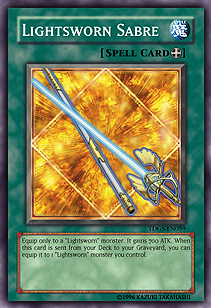 perfect for competitive metagames right now, letting Wulf, Garoth, Jain, and Celestia attack over Stardust Dragon without expending any card presence—you get to keep your Sabre after you attack. The Sabre lets Jain, Wulf, and Celestia trade with or defeat Thought Ruler Archfiend as well. A build optimized to take advantage of this would run three Celestia cards, three Wulf cards, and two or three copies each of Garoth and Jain, giving it a very high average ATK. That means a lot of force in a format where raw numbers can win games.
perfect for competitive metagames right now, letting Wulf, Garoth, Jain, and Celestia attack over Stardust Dragon without expending any card presence—you get to keep your Sabre after you attack. The Sabre lets Jain, Wulf, and Celestia trade with or defeat Thought Ruler Archfiend as well. A build optimized to take advantage of this would run three Celestia cards, three Wulf cards, and two or three copies each of Garoth and Jain, giving it a very high average ATK. That means a lot of force in a format where raw numbers can win games.
So Lightsworn Sabre’s ATK bonus looks small, but it’s actually perfect given the monsters that are seeing play right now (especially Stardust Dragon). Beyond that, the Sabre’s graveyard effect is tremendous. Anyone who’s played Lightsworn recently knows that Charge of the Light Brigade has made it much easier to amass big fields with Lumina, making for more cards sent to the graveyard in the end phase. As long as you send the Sabre to the graveyard with an end phase effect or Solar Recharge (and not as a cost for Charge or Celestia), you get to equip it for free. That conventional loss of two cards when your equipped monster is destroyed just doesn’t hurt as much when the equip spell didn’t cost you anything to activate.
Even on smaller Lightsworn monsters the Sabre can be useful in a pinch: boosting Lumina, Lightsworn Summoner’s ATK to 1700 for free is pretty darn good, and a 2300 ATK Ehren is a force to be reckoned with. Even if you’re forced to play Lightsworn Sabre from your hand, the damage it creates can add up quickly, and can often provide that last little push you needed to win. As a worst-case scenario, you can hold it and simply wait to activate it when your opponent drops a big Synchro. Most TeleDAD decks still aren’t playing enough defense to stop you.
Lightsworn need to be able to attack over Stardust Dragon more reliably. If they can do that, I don’t doubt that we’ll see one in the finals some time soon. I really think that despite our initial impressions of Lightsworn Sabre, it could be the card that finally puts Lightsworn over the top. It’s in the middle of a "perfect storm" right now as far as gameplay patterns are concerned, and it’s a very good addition to an aggressive Lightsworn deck. It complements Honest nicely by making your monsters even harder to attack, and as a card you intend to try and mill to the graveyard, it’s far better than Necro Gardna.
I sincerely think Lightsworn Sabre can surprise you—try it for yourself in an optimized build, and watch how fast those Synchros hit the dirt!
—Jason Grabher-Meyer